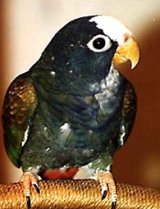
Feather cysts, baldness, brown hypertrophy of the cere, polyfollicles, and knemidokoptes mites were discussed in a previous article Common Skin and Feather Disorders Part I.
While additional disorders, such as myialges nudus mites, xanthomas skin patches, ulcerative dermatitis, abscesses and tumors of the uropygial or preen gland and bumble foot were covered in Common Skin and Feather Disorders Part II.
Constricted Toe Syndrome
This condition is seen most often in neonate (young) psittacines – especially African greys, macaws and eclectus. Any toe may be affected. A 360 degree constriction occurs resulting in swelling, loss of blood supply and finally death of the distal portion of the toe. This condition seems similar to the lesion caused by wrapping a piece of string or thread around the toe. The cause of constricted toe syndrome is unknown, but low humidity in the brooder is syspected as part of the cause. If this condition is recognized early, the fibrous band may be removed surgically thus restoring circulation.
Dry Gangrene of the extremities
This condition is seen most commonly in small birds such as canaries, keets and finches, It is caused by improper nesting material becoming wrapped around the toes and feet, cutting off circulation to the digits. Swelling occurs and circulation is compromised distal to the string. If this is recognized early, the string may be removed, restoring circulation. Many birds have so much swelling above and below the constriction it becomes impossible to visualize the thread or string. If circulation has been comporomised, too long, the distal portion of the toe sloughs.
Lipomas
Lipomas are benign fatty tumors. They frequently occur in birds – especially amazons, rosebreated cockatoos and budgies. High energy diets, obesity and genetic predisposition contribute to the development of lipomas.
Lipomas usually occur on the sternum or abdomen, but can occur anywhere. Large lipomas may interfere with perching or flight and may become repeatedly traumatized. Birds may pick at their lipomas causing bleeding and infection.
Conversion to a balanced diet and increased exercise may be adequate for small lipomas, while surgery may be necessary for large ones.
Beak and Feather Disease
Beak and Feather Disease is caused by a cirrovirus. Although first identified in cockatoos, it has been identified in numerous other psittacine species – especially cockatoos, cockatiels and lovebirds. Beak and Feather Disease causes symmetric feather dystrophy and loss, beak abnormalities and eventual death.
Infected birds shed the virus through oral and respiratory secretions, feces and feather dust. The virus attacks the immune system resulting in secondary bacterial and fungal infections.
An age-related susceptibility to the virus is believed to exist because very young birds exposed to the virus often develop severe disease and die while older birds exposed to the virus may remain asymptomatic.
Peracute, acute and chronic forms of Beak and Feather Disease exist. In the peracute form, neonates develop septicemia, pneumonia, rapid weight loss and die. This syndrome is most common in cockatoos and greys.
In the acute form, which occurs in fledgling birds during their first feather formation, depression and the development of necrotic, bending, bleeding or prematurely shed feathers occurs. Some birds may die with minimal feather changes. This form is most common in lovebirds and certain cockatoos.
The chronic form of Beak and Feather Disease is characterized by the progressive appearance of abnormal feathers after each molt. Retained feather sheaths, hemorrage withiin the pulp cavity, and short clubbed feathers may be present. Loss of powder down, abnormal beak growth, necrosis, and fracture of the beak may occur.
All new birds should be blood tested for Beak and Feather Virus as part of their initial health screen.
Additional information on skin and feather disorders, can be found in the other articles in this series – Common Skin and Feather Disorders Part I and Common Skin and Feather Disorders Part II.

